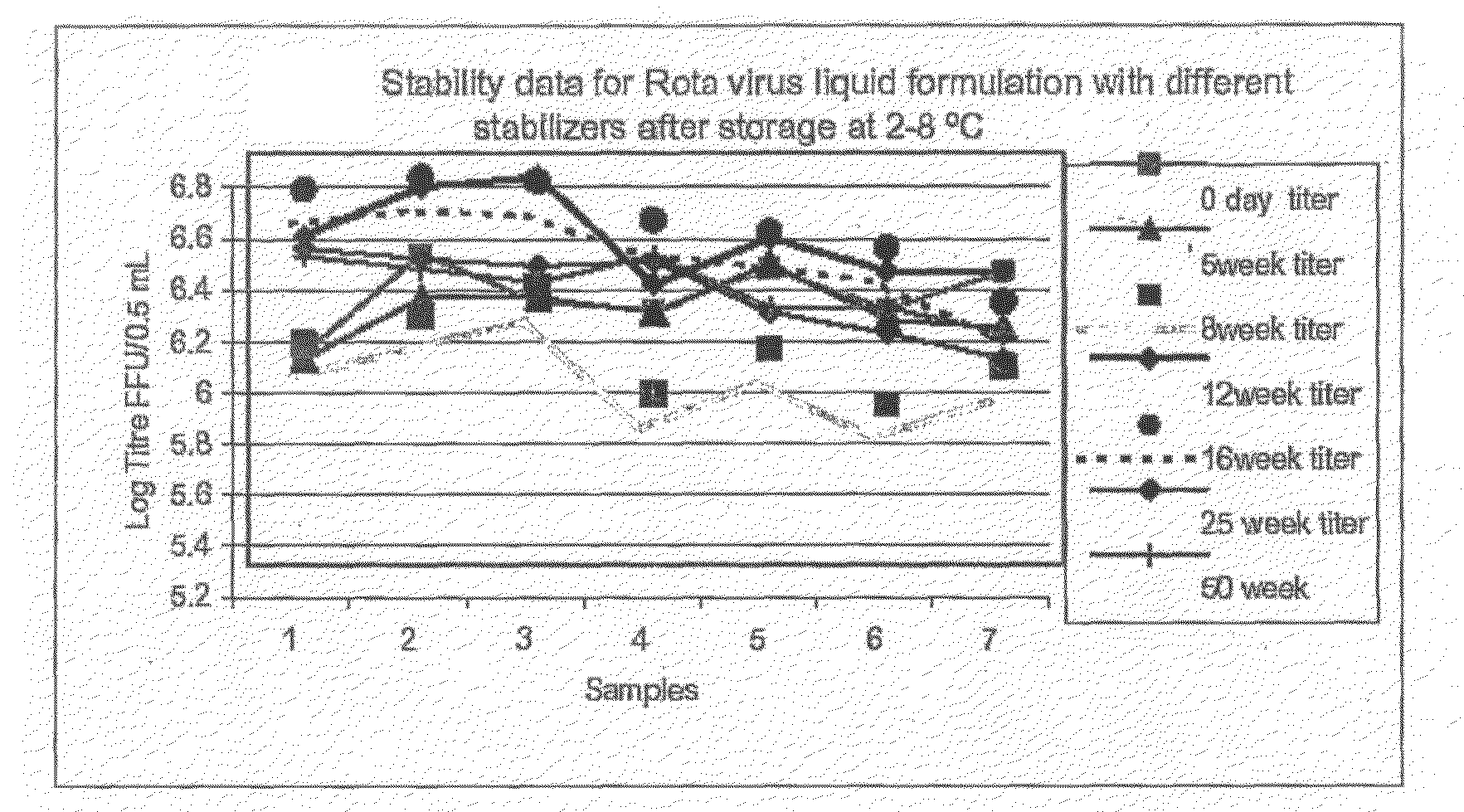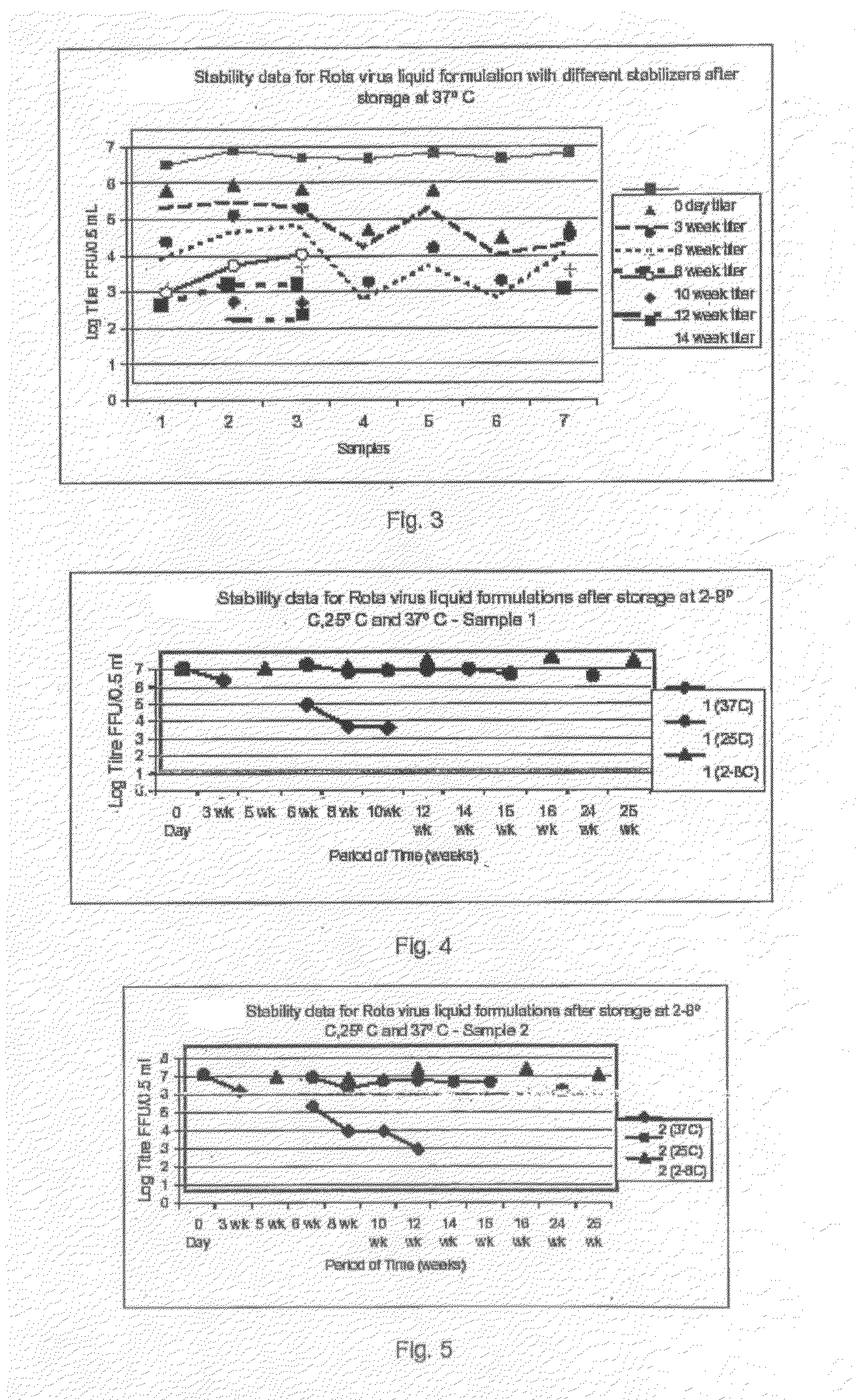Composition Useful as a Vaccine
a technology of composition and vaccine, applied in the direction of dsrna viruses, viral antigen ingredients, biochemistry apparatus and processes, etc., can solve the problems of significant challenges in the preparation of stable vaccine formulation, significant potency loss, and infant and young child deaths from diarrhoea
- Summary
- Abstract
- Description
- Claims
- Application Information
AI Technical Summary
Problems solved by technology
Method used
Image
Examples
example 1
[0076]The original rotavirus vaccine strains 116E (G9P[11]) and I321 (G10P[11]) were supplied by NIAID, NIH, Bethesda, USA to Bharat Biotech International Limited as Vaccine Starting Material strains, were grown in AGMK, MA104 and SPAGMK cell substrate. For the commercial production of rotavirus vaccine these rotavirus strains were adapted to Vero cell substrate and human diploid cells, MRC-5 cell substrate by serial passage of the rotavirus. Calcium chloride concentration ranging from 100 μg / ml to 1000 μg / ml and / or trypsin concentration ranging from 0.1 μg / ml to 30 μg / ml is evaluated for the activation of the rotavirus and in maintenance medium for time periods ranging from 24 hours to 10 days for high titer virus harvest, at each viral passage in the cell substrate. The yield of the virus in cell culture supernatant is assayed by Rotaclone ELISA kit for the detection of the rotavirus antigen on specific antirotavirus antibody precoated ELISA wells.
[0077]The infectivity titer of ro...
example 2
[0079]The rotavirus strains 116E and I321 can be characterized by number of methods, Which are known in the art. These include, but are not limited to RT-PCR, RNA hybridization, sequence analysis and genus grouping i.e. RNA electropherotyping. Rotavirus of strains 116E and I321 have distinct RNA / RNA hybrid electrophoresis pattern, compared to other rotavirus strains. They have double-stranded RNA (dsRNA) genome consisting of 11 segments ranging in molecular weight from approximately 2.0×106 to 0.2×106 kilo Daltons, out of which VP4 protein is 88,000 Daltons, VP6 is 44,000 Daltons and VP7 is 38000 Daltons. The subtle difference in the mobility of the 11 genomic segments produces a characteristic Electrophoretic band pattern.
[0080]The electrophoretic band pattern of rotavirus strains 116E and I321 can be checked by isolation of genomic dsRNA by Phenol Chloroform method followed by purification with CC41 anion exchange matrix. The purified dsRNA is electrophoresed on 10% polyacrylamide...
example 3
[0081]The rotavirus strains 116E and I321 can be detected using reverse transcriptase polymerase chain reaction (RT-PCR). Generally, RT-PCR comprises contacting RNA obtaining from a sample containing virus with primers, which selectively hybridizes to the VP4 gene (type P11) and / or VP7 gene (type G9 / G10) sequence and synthesizing the first strand of RT-PCR product. A second set of primers, either within the VP4 gene and / or VP7 gene, or located in an adjacent gene would serve as the primer for the second strand synthesis. Primers can have substitutions so long as bases exist for selective hybridization.
PUM
| Property | Measurement | Unit |
|---|---|---|
| Temperature | aaaaa | aaaaa |
| Temperature | aaaaa | aaaaa |
| Temperature | aaaaa | aaaaa |
Abstract
Description
Claims
Application Information
 Login to View More
Login to View More - R&D
- Intellectual Property
- Life Sciences
- Materials
- Tech Scout
- Unparalleled Data Quality
- Higher Quality Content
- 60% Fewer Hallucinations
Browse by: Latest US Patents, China's latest patents, Technical Efficacy Thesaurus, Application Domain, Technology Topic, Popular Technical Reports.
© 2025 PatSnap. All rights reserved.Legal|Privacy policy|Modern Slavery Act Transparency Statement|Sitemap|About US| Contact US: help@patsnap.com



